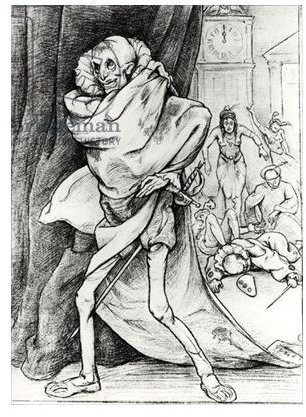Imagery in "The Masque of the Red Death" by Edgar Allan Poe: A Literary Analysis
Imagery is the use of figurative or descriptive language to create a vivid mental picture. It involves at least one of the five senses–sight, sound, touch, feel, taste. Imagery in “The Masque of the Red Death” is ghastly.
Example of Imagery - “There were sharp pains, and sudden dizziness, and then profuse bleeding at the pores, with dissolution. The scarlet stains upon the body and especially upon the face of the victim, were the pest ban which shut him out from the sympathy of his fellow men.” (145).
Senses - Sight, Touch
Analysis - Poe establishes the mood and setting of the story with the vivid description of the Red Death. The passage establishes the horror of the disease and explains why the guests would react to the blood stained intruder at the end of the story.
Imagery in the 7th Room
Example of Imagery - “The seventh apartment was closely shrouded in black velvet tapestries that hung all over the ceiling and down the walls, falling in heavy folds upon the carpet of the same material and hue” (146).
Senses - Sight, Touch
Analysis: The oppressiveness of the 7th room contrasts the gaiety of the previous six. The darkness of the room and the heaviness and darkness of the curtain symbolizes death. No wonder none of the guests wish to come near it. Note the pun on “shroud.”
**
Example of Imagery - “The panes here were scarlet–a deep color….In the corridors that followed the suite, there stood, opposite to each window, a heavy tripod, bearing a brazier of fire, that projected its rays through the tinted glass and so glaringly illuminated the room. And thus were produced a multitude of gaudy and fantastic appearances…The effect of the firelight that streamed upon the dark hangings through the blood tinted panes was ghastly in the extreme” (146-7)
Senses - Sight
Analysis - So much for peaceful death. The images created by the brazier of fire and blood tinted glass give the room of death a ghastly appearance. The gaudy and fantastic appearances, the blood tinted panes, and the fire create an image of hell, hinting that perhaps the guests and the Prince fear not just the Red Death, but their eternal fate.
More Examples
Example of Imagery - “Its pendulum swung to and fro with a heavy monotonous clang; there came from the brazen lungs of the clock a sound which was clear and loud and deep and exceedingly musical” (147).
Senses - Sound
Analysis - No wonder the musicians stopped when this clock struck. Poe uses personification–brazen lungs–to emphasize the deepness of the “heavy monotonous clang,” a clang that serves as an hourly reminder to the guests that death is approaching.

Example of Imagery - “The figure was tall and gaunt, and shrouded from head to foot in the habilments of the grave…His vesture was dabed in blood and his broad brow, with all the features of the face was besprinkled with the scarlet horror.” (149).
Senses - Sight
Death - The personified Red Death strikes fear and anger in the hearts of Prospero and his guests. Once the Red Death appears, it never leaves.
This post is part of the series: Masque of the Red Death Study Guide
Avoid becoming a bloody mess on your next short story test. Use this study guide and keep the “Red F” away!
- Summary of “The Masque of the Red Death” by Edgar Allan Poe
- Symbolism in “The Masque of the Red Death”
- “The Masque of the Red Death” Literary Analysis: A Look at Imagery
- Setting, Characters, Theme and Irony in “The Masque of the Red Death”
- An Analysis of Edgar Allan Poe Quotes
